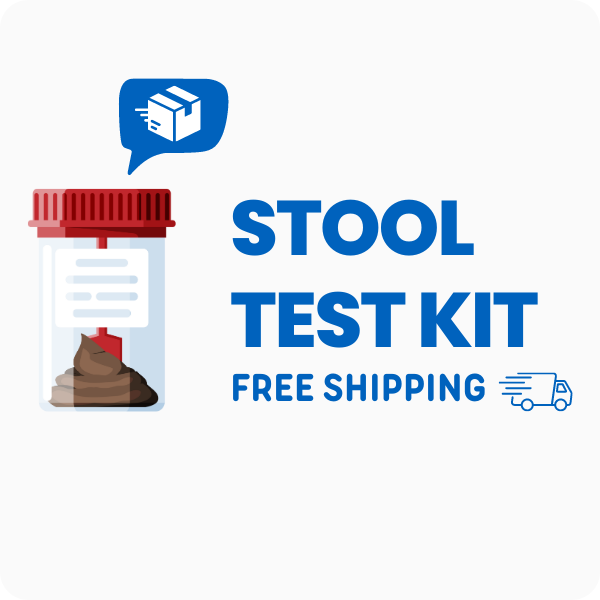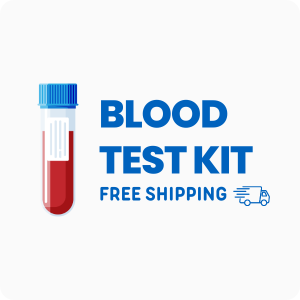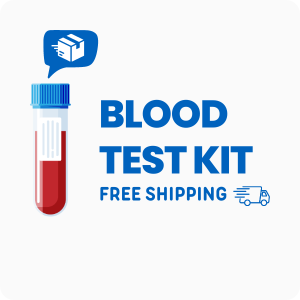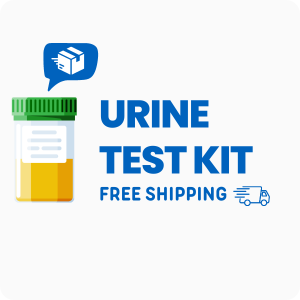Ordering the GI Pathogen Profile by Doctor’s Data
The GI Pathogen Profile by Doctor’s Data helps identify bacteria, viruses, and parasites that can cause digestive problems like diarrhea, stomach pain, and bloating. This stool test is especially useful for pinpointing the cause of ongoing digestive symptoms that have not improved with basic treatments. Interestingly, this test can also detect less common pathogens, such as Cyclospora cayetanensis, which are often missed by standard stool cultures.
Ordering this test can provide clear answers for people dealing with unexplained digestive symptoms. Here are some specific benefits of ordering the GI Pathogen Profile:
- Detects a wide range of bacteria, viruses, and parasites in one sample
- Helps guide targeted treatment by identifying the exact cause of symptoms
- Reduces the need for multiple, separate tests
- Can reveal infections that are not found with routine stool tests
- Supports decisions about travel, food safety, and infection control
Who Should Consider Digestive Pathogen Screening
People who have been dealing with stomach pain, bloating, or diarrhea after a recent trip or after eating at a new restaurant may benefit from this test. For example, someone who has returned from a vacation and is now experiencing ongoing digestive issues may want to find out if a gut infection is the cause.
Ordering this test may also be helpful in these situations:
- Long-lasting diarrhea that does not improve with over-the-counter remedies
- Sudden stomach upset after eating undercooked or raw foods
- Digestive symptoms following antibiotic use
- Unexplained fatigue and weight loss with stomach discomfort
- Recurring mild fevers and nausea that seem to follow a pattern after certain meals
This test can help identify the specific cause of digestive symptoms, allowing for more focused treatment and faster relief. Delaying this test may allow infections to persist, which can make symptoms harder to manage and may lead to more complicated issues over time. To get clear answers and targeted solutions, consider ordering this comprehensive stool test.
How to Prepare for Digestive Infection Testing
Fasting is not required for this stool test, but be sure to follow the instructions included in your test kit for the best results. Always follow any directions your doctor or healthcare provider gives you, as these can help make sure your sample is collected and shipped correctly.
Labs Included When Ordering Your GI Pathogen Profile
| Test Name | Reference Range | Significance | Low and High Levels of GI Pathogen Profile |
|---|---|---|---|
| Viruses | |||
| Adenovirus F40&41 | Not detected | Adenovirus F40&41 can cause diarrhea, especially in children, and may lead to dehydration if not identified and managed. | High levels mean an active adenovirus infection is present, which can cause stomach flu symptoms.
Low levels mean no current adenovirus infection. |
| Astrovirus | Not detected | Astrovirus is a common cause of viral gastroenteritis, leading to mild to moderate diarrhea, mostly in children and older adults. | High levels mean a current astrovirus infection is likely.
Low levels mean no astrovirus infection is present. |
| Norovirus GI&GII | Not detected | Norovirus is a leading cause of stomach flu, causing sudden vomiting and diarrhea, and is highly contagious. | High levels mean an active norovirus infection, which can spread quickly.
Low levels mean norovirus is not present. |
| Rotavirus A | Not detected | Rotavirus A is a common cause of severe diarrhea in infants and young children, sometimes leading to dehydration. | High levels mean a current rotavirus infection.
Low levels mean no rotavirus infection is detected. |
| Sapovirus (I, II, IV and V) | Not detected | Sapovirus can cause outbreaks of gastroenteritis, especially in children, with symptoms like vomiting and diarrhea. | High levels mean sapovirus is present and may be causing symptoms.
Low levels mean sapovirus is not detected. |
| Bacteria | |||
| Campylobacter (jejuni, coli and upsaliensis) | Not detected | Campylobacter species are common causes of bacterial diarrhea, often linked to undercooked poultry or contaminated water. | High levels mean a Campylobacter infection is present.
Low levels mean no Campylobacter infection. |
| Clostridium difficile (Toxin A&B) | Not detected | Clostridium difficile can cause severe diarrhea and colitis, especially after antibiotic use, and is important to detect early. | High levels mean a C. difficile infection is likely.
Low levels mean C. difficile is not present. |
| E. coli | Not detected | E. coli can cause a range of symptoms from mild stomach upset to severe diarrhea, depending on the strain. | High levels mean a possible E. coli infection.
Low levels mean E. coli is not detected. |
| Enteroaggregative E. coli (EAEC) | Not detected | EAEC is a type of E. coli that can cause persistent diarrhea, especially in children and travelers. | High levels mean EAEC is present and may be causing symptoms.
Low levels mean EAEC is not detected. |
| Enteropathogenic E. coli (EPEC) | Not detected | EPEC is another E. coli strain that can cause watery diarrhea, especially in young children. | High levels mean EPEC is present.
Low levels mean EPEC is not detected. |
| Enterotoxigenic E. coli (ETEC) lt&st | Not detected | ETEC is a common cause of traveler’s diarrhea, producing toxins that lead to watery stools and stomach cramps. | High levels mean ETEC is present and may be causing symptoms.
Low levels mean ETEC is not detected. |
| Plesiomonas shigelloides | Not detected | Plesiomonas shigelloides can cause diarrhea, especially after eating raw seafood or drinking contaminated water. | High levels mean a Plesiomonas infection is present.
Low levels mean Plesiomonas is not detected. |
| Salmonella | Not detected | Salmonella is a common cause of food poisoning, leading to diarrhea, fever, and stomach cramps. | High levels mean a Salmonella infection is present.
Low levels mean Salmonella is not detected. |
| Shiga-like toxin-producing E. coli (STEC) stx1&stx2 | Not detected | STEC can cause severe stomach pain, bloody diarrhea, and sometimes kidney problems, making early detection important. | High levels mean STEC is present and may cause severe symptoms.
Low levels mean STEC is not detected. |
| Shigella & Enteroinvasive E. coli (EIEC) | Not detected | Shigella and EIEC can cause dysentery, with symptoms like fever, stomach cramps, and bloody stools. | High levels mean Shigella or EIEC infection is present.
Low levels mean neither is detected. |
| Vibrio (parahaemolyticus, vulnificus and cholerae) | Not detected | Vibrio species can cause watery diarrhea, often after eating raw or undercooked seafood or exposure to seawater. | High levels mean a Vibrio infection is present.
Low levels mean Vibrio is not detected. |
| Vibrio cholerae | Not detected | Vibrio cholerae is the cause of cholera, which leads to severe watery diarrhea and dehydration. | High levels mean cholera infection is present.
Low levels mean cholera is not detected. |
| Yersinia enterocolitica | Not detected | Yersinia enterocolitica can cause fever, abdominal pain, and diarrhea, sometimes mimicking appendicitis. | High levels mean Yersinia infection is present.
Low levels mean Yersinia is not detected. |
| Parasites | |||
| Cryptosporidium | Not detected | Cryptosporidium is a parasite that can cause watery diarrhea, especially in people with weakened immune systems. | High levels mean a Cryptosporidium infection is present.
Low levels mean Cryptosporidium is not detected. |
| Cyclospora cayetanensis | Not detected | Cyclospora cayetanensis can cause long-lasting diarrhea and stomach cramps, often linked to imported fresh produce. | High levels mean Cyclospora infection is present.
Low levels mean Cyclospora is not detected. |
| Entamoeba histolytica | Not detected | Entamoeba histolytica can cause amebiasis, leading to diarrhea, stomach pain, and sometimes liver problems. | High levels mean Entamoeba infection is present.
Low levels mean Entamoeba is not detected. |
| Giardia duodenalis | Not detected | Giardia duodenalis is a parasite that causes giardiasis, leading to diarrhea, gas, and stomach cramps, often after drinking untreated water. | High levels mean Giardia infection is present.
Low levels mean Giardia is not detected. |
Reference ranges may change slightly as labs update their methods and guidelines. Always check your report for the most current information.
GI Pathogen Profile FAQ
Is there GI Pathogen Profile testing near me?
This is a home test kit, so you can collect your stool sample at home and send it to the lab using the prepaid shipping label. For people with ongoing stomach pain or diarrhea, being able to collect the sample at home means you don’t have to travel while feeling unwell, making the process more comfortable and accessible.
How do I interpret the test results?
Your treating physician should review your results, but we also offer a one-on-one test results review with our clinical team to help you understand what your results mean and what steps to take next.
What is the cost of the test?
The price listed for the GI Pathogen Profile includes standard shipping to your address and return shipping to the lab; draw fees may apply. Ordering this test can help you quickly find out if a gut infection is causing your symptoms, so you can start the right treatment sooner.
How often should I retest?
Retesting is usually recommended if symptoms return or do not improve after treatment, or if you have a new exposure to contaminated food or water. Repeating the test can confirm if the infection has cleared or if a new pathogen is present.
How accurate is the test?
This test uses multiplex PCR (polymerase chain reaction) technology to detect genetic material from bacteria, viruses, and parasites in stool samples. The GI Pathogen Profile has a specificity of 99% and a sensitivity of 98%, providing a high level of confidence in the results. TrueHealthLabs.com partners with CLIA-certified and CAP-certified laboratories to uphold rigorous testing standards for dependable results.
Medical Review Board
Reviewed by Jeff Donohue M.D. from Body Logic and Brady Hurst DC, CCCN. Written by True Health Lab’s team of editorial health contributors.
Disclaimer: This information is for educational purposes only and not intended as medical advice. Consult your healthcare provider for personalized guidance.
Why Customers Trust True Health Labs - What People are saying
Also rated 4.6 out of 5 based on 3452 ShopperApproved reviews- See all TrueHealthLabs.com reviews.









